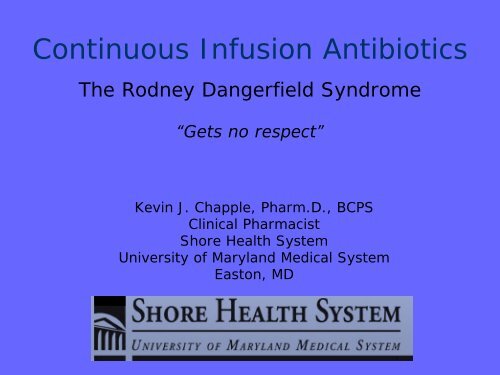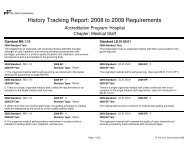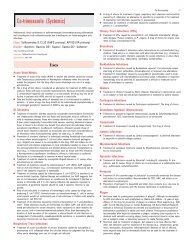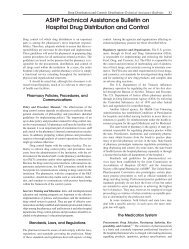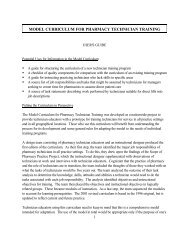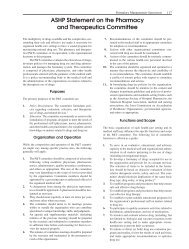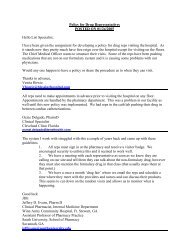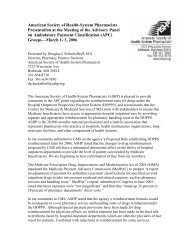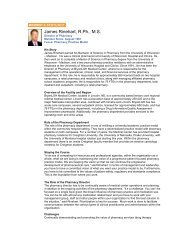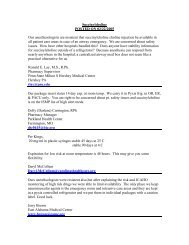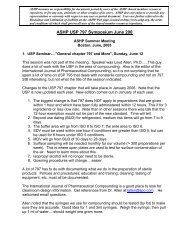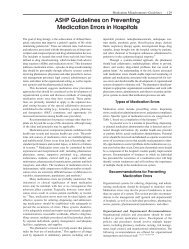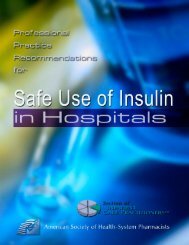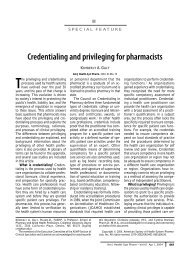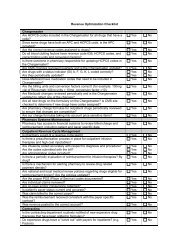The Rodney Dangerfield Syndrome - American Society of Health ...
The Rodney Dangerfield Syndrome - American Society of Health ...
The Rodney Dangerfield Syndrome - American Society of Health ...
Create successful ePaper yourself
Turn your PDF publications into a flip-book with our unique Google optimized e-Paper software.
Continuous Infusion Antibiotics<br />
<strong>The</strong> <strong>Rodney</strong> <strong>Dangerfield</strong> <strong>Syndrome</strong><br />
“Gets no respect”<br />
Kevin J. Chapple, Pharm.D., BCPS<br />
Clinical Pharmacist<br />
Shore <strong>Health</strong> System<br />
University <strong>of</strong> Maryland Medical System<br />
Easton, MD
Time-Dependent Killing<br />
(TDK)<br />
• Keep serum level above MIC<br />
• Penicillins<br />
• Cephalosporins<br />
• Vancomycin<br />
• Carbapenems<br />
• Monobactams<br />
• Clindamycin<br />
• Linezolid<br />
• Macrolides
Concentration-Dependent<br />
Killing (CDK)<br />
• Efficacy <strong>of</strong> killing <strong>of</strong> bacteria is<br />
enhanced with higher peaks,<br />
regardless <strong>of</strong> trough<br />
• Aminoglycosides<br />
• Fluoroquinolones<br />
• Continuous infusion antibiotics are<br />
NOT typically considered for<br />
antimicrobials that exhibit CDK.
0 4 8 12 16 24<br />
Time (hours)<br />
Intermittent<br />
Continuous<br />
Minimum Inhibitory Concentration
Continuous Infusion<br />
• Keep serum concentrations above<br />
MIC at all times<br />
• Takes advantage <strong>of</strong> TDK<br />
• Possible cost advantage<br />
• May be able to use less drug per day<br />
compared to intermittent dosing.
In the Literature…<br />
• Ceftazidime<br />
• Febrile neutropenia<br />
• Pulmonary Infections<br />
• Piperacillin/tazobactam<br />
• Intra-abdominal infections<br />
• Pulmonary Infections<br />
• Vancomycin<br />
• Osteomyelitis<br />
• General Critical Infections<br />
• Cefepime<br />
• Pulmonary<br />
• General Critical Infections
Dosing<br />
• Most trials use same daily dose<br />
• However, may be feasible to use<br />
lower daily doses in many cases<br />
• Potential cost savings<br />
• Less exposure to high peaks<br />
• May minimize adverse effects<br />
• High peaks NOT needed for antimicrobials<br />
that exhibit TDK
Stability<br />
• One <strong>of</strong> the biggest concerns from a<br />
theoretical standpoint<br />
• Some literature on most <strong>of</strong> the<br />
aforementioned antimicrobials<br />
• Most stable in solution for 12-24 hours
Summary - Advantages<br />
• Acquisition cost savings<br />
• Less nursing and pharmacy time<br />
• Take full advantage <strong>of</strong><br />
pharmacodynamic principles<br />
• Avoid high peaks<br />
• No clinical advantage to high peaks with<br />
antimicrobials that work on cell wall<br />
• ? Avoidance <strong>of</strong> some adverse effects
Summary - Disadvantages<br />
• May need additional IV access<br />
• Stability<br />
• Most relevant antibiotics not an issue<br />
• Possible increase in other ADR’s<br />
• Line sepsis<br />
• Thrombophlebitis
Conclusions<br />
• File it in your mind!!<br />
• Complicated patients<br />
• Known or suspected intermediate sensitivity<br />
• Endocarditis, Osteomyelitis, Meningitis, Cystic<br />
Fibrosis<br />
• Vancomycin CI Kinetics very interesting in<br />
meningitis<br />
• Literature would support use in:<br />
• complicated pneumonia<br />
• intra-abdominal infections<br />
• infections in critically ill
Brushing Up…<br />
• Kasiakou SK, Sermaides GJ, Michalopoulos A, Soteriadis ES,<br />
Falagas ME. Continuous versus intermittent administration <strong>of</strong><br />
antibiotics: a meta-analysis <strong>of</strong> randomised controlled clinical<br />
trials. Lancet Infect Dis 2005;5:581-9.<br />
• Benko AS, Cappelletty DM, Kruse JA, Rybak MJ. Continuous<br />
infusion versus intermittent administration <strong>of</strong> ceftazidime in<br />
critically ill patients with suspected gram-negative infections.<br />
Antimicrob Agents Chemother 1996; 40: 691–5.<br />
• Di Filippo A, De Gaudio AR, Novelli A, et al. Continuous infusion<br />
<strong>of</strong> vancomycin in methicillin-resistant staphylococcus infection.<br />
Chemotherapy 1998; 44: 63–8.<br />
• Hanes SD, Wood GC, Herring V, et al. Intermittent and<br />
continuous ceftazidime infusion for critically ill trauma patients.<br />
Am J Surg 2000; 179: 436–40.<br />
• Jaruratanasirikul S, Sriwiriyajan S, Ingviya N. Continuous<br />
infusion versus intermittent administration <strong>of</strong> cefepime in<br />
patients with Gram-negative bacilli bacteraemia. J Pharm<br />
Pharmacol 2002; 54:1693–6.
Brushing Up…<br />
• Nicolau DP, McNabb J, Lacy MK, Quintiliani R, Nightingale CH.<br />
Continuous versus intermittent administration <strong>of</strong> ceftazidime in<br />
intensive care unit patients with nosocomial pneumonia. Int J<br />
Antimicrob Agents 2001; 17: 497–504.<br />
• Wysocki M, Delatour F, Faurisson F, et al. Continuous versus<br />
intermittent infusion <strong>of</strong> vancomycin in severe staphylococcal<br />
infections: prospective multicenter randomized study. Antimicrob<br />
Agents Chemother 2001; 45: 2460–7.<br />
• Florea NR, Kotapati S, Kuti JL, Geissler EC, Nightingale CH, Nicolau<br />
DP. Cost analysis <strong>of</strong> continuous versus intermittent infusion <strong>of</strong><br />
piperacillin-tazobactam: a time-motion study. Am J <strong>Health</strong> Syst<br />
Pharm 2003; 60: 2321–7.<br />
• Grant EM, Kuti JL, Nicolau DP, Nightingale C, Quintiliani R. Clinical<br />
efficacy and pharmacoeconomics <strong>of</strong> a continuous-infusion<br />
piperacillin-tazobactam program in a large community teaching<br />
hospital. Pharmacotherapy 2002; 22: 471–83.<br />
• Hitt CM, Nightingale CH, Quintiliani R, Nicolau DP. Cost comparison<br />
<strong>of</strong> single daily i.v. doses <strong>of</strong> ceftriaxone versus continuous infusion <strong>of</strong><br />
cefotaxime. Am J <strong>Health</strong> Syst Pharm 1997; 54: 1614–18.
Brushing Up…<br />
• Mac Gowan AP, Bowker KA. Continuous infusion <strong>of</strong> beta lactam<br />
antibiotics. Clin Pharmacokinet 1998; 35: 391-402.<br />
• Alou L, Aguilar L, Sevillano D, Gimenez MJ, Echeverria O, Gomez-<br />
Lus ML, Prieto J. Is there a pharmacodynamic need for the use<br />
<strong>of</strong> continuous versus intermittent infusion with ceftazidime<br />
against pseudomonas aeruginosa? An in vitro pharmacodynamic<br />
model. JAC 2005; 55;209-13.<br />
• Nicolau DP, Nightengale CH, Banevicius MA, Fu Q, Quintiliani R.<br />
Serum bactericidal activity <strong>of</strong> ceftazidime: continuous infusion<br />
versus intermittent injections. Antimicrob Agents Chemother<br />
1996;40:61-4.<br />
• Albanese J, Leone M, Bruguerolle B, Ayem ML, Lacarelle B, Martin<br />
C. Antimicrob Agents Chemother 2000;44:1356-8.<br />
• Jacqueline C, Batard E, Perez R, Boutoille D, Hamel A, Caillon J,<br />
Kergueris MF, Potel G, Bugnon D. Antimicrob Agents Chemother<br />
2002;46:3706-11.


